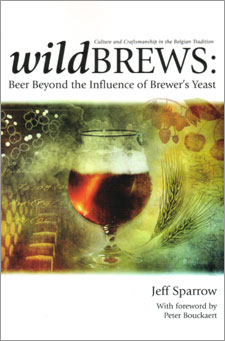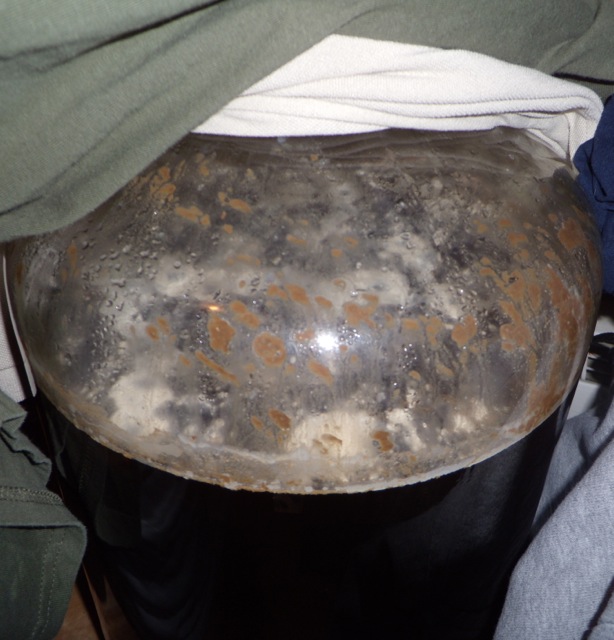 Homebrewers are taught from the very beginning that sanitation is priority #1, and that anything growing in your beer other than saccharomyces (brewer’s yeast) is the worst thing possible, and as a result, we spend a lot of time cleaning and sanitizing. Wild Brews by Jeff Sparrow brings to light a tradition of making beer with saccharomyces in concert with a handful of other microorganisms, and it’s good.
Homebrewers are taught from the very beginning that sanitation is priority #1, and that anything growing in your beer other than saccharomyces (brewer’s yeast) is the worst thing possible, and as a result, we spend a lot of time cleaning and sanitizing. Wild Brews by Jeff Sparrow brings to light a tradition of making beer with saccharomyces in concert with a handful of other microorganisms, and it’s good.
Of these styles, most Americans would be lucky to have heard of a lambic beer before, most of us have not. Wild brews introduces us to a handful of beer styles going back hundreds of years, all made with wild organisms. While science has allowed us to identify many of these organisms, and Wyeast and White Labs have clean cultures available commercially, Sparrow tells us that nothing is quite the same as when you let nature take it’s own course.
These beers become more like a fine wine, a product of their environment (or terrior) and a product of decades if not centuries of developing a signature blend of microorganisms within the brewery, which cannot be replicated by pitching a culture from a lab. These organisims live in the very walls of the brewery, and most importantly, in the oak barrels that the beer is aged in.
Sparrow takes the reader through a history of wild brewing, highlights the most well-known styles, tells us where we might travel to find examples still being produced, and then spends several chapters getting down to the nitty-gritty of production, fermentation and packaging of these beer varieties, rich in tradition, and like a fine wine, worth the wait (some of these beers take 3 or more years to get from brew to bottle).
For styles, Sparrow covers Flanders Red and Brown ales, Lambics and Gueuzes. For each style, he provides a history and regional background, as well as a standard formula one could use to formulate a recipe, as well as a description of each beer’s flavor profile. In the history chapter, Sparrow covers not only the evolution of the different beer types, but the where and the why of it all, broken down by region. The chapter Drinking Wild Beer covers current breweries manufacturing wild beer, and what they have to offer, including some US breweries.
The rest of the book moves from the where and the why and into the how. Beer Souring Microorganisms covers the major bugs responsible for wild brewing, but the reader is reminded that there are many that are not catalogued as easily that play an important role in authentic lambic beers. Production Methods, Wild Fermentation, Fermentation and Maturation Vessels and Finishing the Beer continue to break down the process into additional chunks, walking the reader through each phase with plenty of information.
If you have ever had a sour or an acid beer, and want to learn more, I would strongly recommend this book. I know that after reading it, I’m not far away from my first beer made with more than saccharomyces.
 I told myself initially that I just had to wait until New Year’s to keg it, then it became the end of January. Now, here it is, nearly April, and it’s still in the primary fermenter. Interestingly, in just the past month or two, it’s taken a significant turn visually. Vinnie Cilurzo of Russian River has said that you shouldn’t look at a sour beer while it’s fermenting, but isn’t that curiosity part of what brought homebrewers to the hobby in the first place?
I told myself initially that I just had to wait until New Year’s to keg it, then it became the end of January. Now, here it is, nearly April, and it’s still in the primary fermenter. Interestingly, in just the past month or two, it’s taken a significant turn visually. Vinnie Cilurzo of Russian River has said that you shouldn’t look at a sour beer while it’s fermenting, but isn’t that curiosity part of what brought homebrewers to the hobby in the first place?
 Homebrewers are taught from the very beginning that sanitation is priority #1, and that anything growing in your beer other than saccharomyces (brewer’s yeast) is the worst thing possible, and as a result, we spend a lot of time cleaning and sanitizing. Wild Brews by Jeff Sparrow brings to light a tradition of making beer with saccharomyces in concert with a handful of other microorganisms, and it’s good.
Homebrewers are taught from the very beginning that sanitation is priority #1, and that anything growing in your beer other than saccharomyces (brewer’s yeast) is the worst thing possible, and as a result, we spend a lot of time cleaning and sanitizing. Wild Brews by Jeff Sparrow brings to light a tradition of making beer with saccharomyces in concert with a handful of other microorganisms, and it’s good.